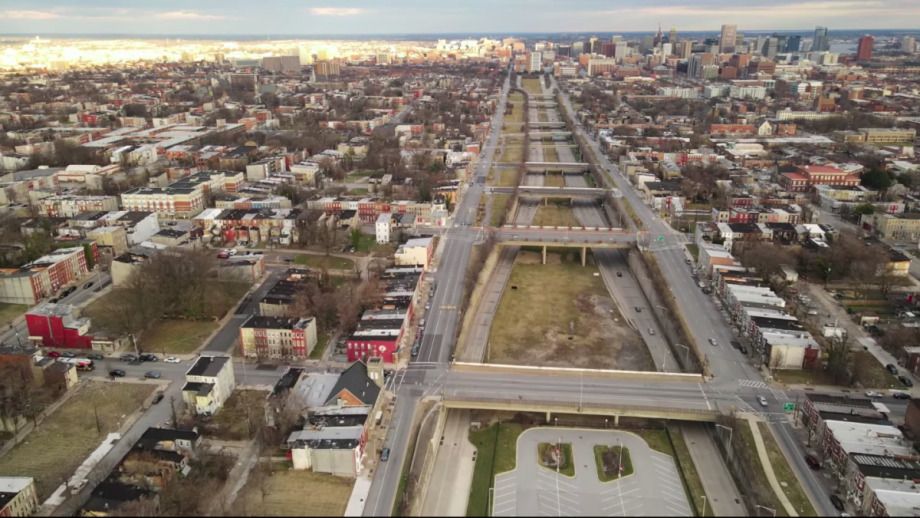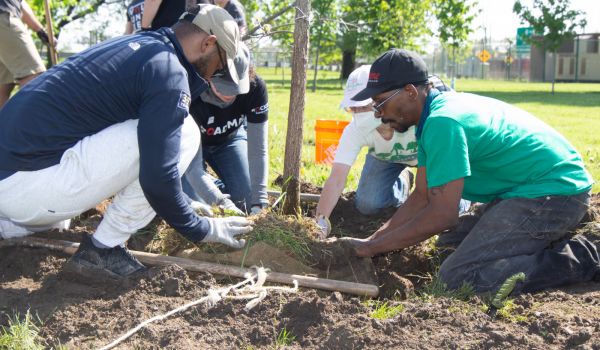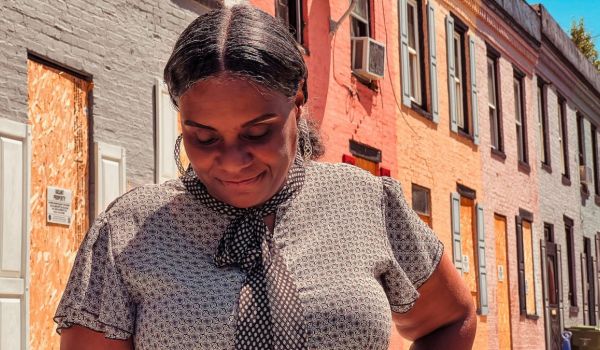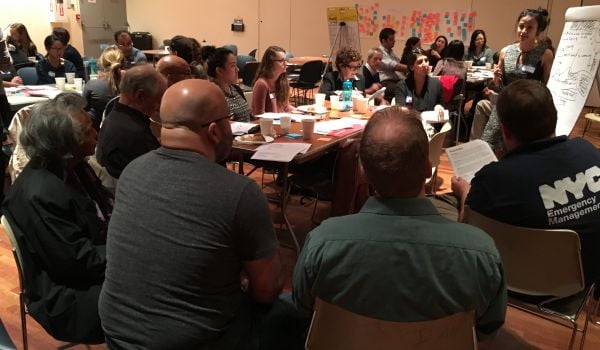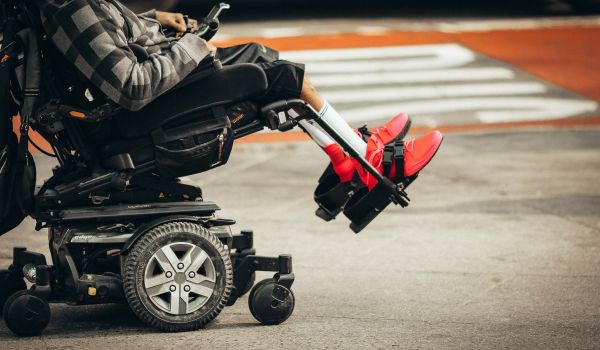This story is co-published with Nexus Media News and was made possible by a grant from the Open Society Foundations.
Growing up in Rosemont, a once vibrant Black neighborhood on Baltimore’s West Side, Glenn Smith remembers “having everything you needed” — parks, markets and even a movie theater — within walking distance of the home he shared with his parents and seven siblings. “It was a Norman Rockwell existence,” he said.
But in 1974, when Smith was 19 years old and living at home, that existence came to an abrupt end. That year, Smith’s family was informed their house would be demolished to make way for Interstate Highway 170 that would connect downtown Baltimore with its expanding ring of suburbs.
During the middle of the last century, hundreds of thousands of Black Americans received similar eviction notices, as city planners around the country began plotting out new highway systems to cater to the car-centric, suburban lifestyle growing in popularity with middle-class white people. Generous federal funding for these projects — as much as 90 cents on the dollar — encouraged officials to go big, opening up large tracts of land for redevelopment by clearing out so-called slums — areas where a disproportionate number of Black residents lived.
In Baltimore, this meant neighborhoods that had long been the epicenter of Black life. “They called it a ghetto, but that wasn’t the case,” said Smith. “It was a thriving community.”
In the end, only 1.4 of the slated 2.3 miles of I-170 were ever built. The city’s larger highway expansion project was scrapped in 1979, thanks to staunch opposition from environmental and neighborhood activists. But in West Baltimore, the damage had already been done. More than 1,500 residents were displaced; 971 homes, 62 businesses, and one school got the wrecking ball. The area would never recover.
“It was like taking the heart out of the body. All the extremities just dried up and died,” said Smith. Today the area is plagued by high crime, low property values, joblessness, and a stark lack of economic investment.
In the years since, the road, which was redesignated as U.S. Route 40, has become known as “the Highway to Nowhere.” Others call it “the ditch.” The sunken highway slashes through the landscape like a deep wound, separating neighborhoods and creating air and noise pollution for nearby residents. According to the EPA, people who live near major roadways have higher rates of asthma, cardiovascular disease, and decreased lung function; road noise can also play a role in health problems associated with roadway exposure.
Now, nearly half a century later, the Highway to Nowhere may finally meet its end. The Inflation Reduction Act, which allocates nearly $370 billion in spending and tax credits to fight climate change, includes $3 billion to support highway removal. That funding comes a year after the federal government set aside $1 billion in the 2021 Infrastructure Investment and Jobs Act for the US Department of Transportation’s (DOT) Reconnecting Communities Pilot Program.
The city of Baltimore has announced it will seek grant money to tear down U.S. Route 40 through the Reconnecting Communities program. Grantees will be announced in the spring of 2023.
Shima Hamidi, assistant professor in environmental health and engineering at the John Hopkins Bloomberg School of Public Health, said that funding has always been the biggest barrier to highway removal, a complicated, expensive undertaking. “It’s never been a priority on the federal level,” she said.
That has changed with the Biden Administration, she said. “Equity and environmental justice are now the number one priority at the DOT. It’s a unique opportunity. We should grab it.”
This sudden investment in highway removal comes on the heels of a number of successful such projects around the country. In 2017, Rochester’s East Inner Loop — another sunken highway built atop a Black neighborhood — was transformed into a boulevard that has seen a record number of pedestrians and bike riders using its sidewalks and bike lanes. In 2004, officials in Chattanooga, Tennessee removed a four-lane freeway to reconnect downtown to the city’s riverfront; two decades later the revitalized area has become the centerpiece of the city’s economic development efforts.
Rick Cole, executive director for the Congress for New Urbanism (CNU), a nonprofit that champions walkable cities, said that when highways are removed, “we see a blooming of economic activity in areas that have long been disadvantaged.” Cole said that getting rid of “one of these monsters” doesn’t just correct the “misguided urban programs of the past,” it also addresses public health inequalities and the climate crisis. Creating denser, more walkable urban spaces with less traffic will go a long way in reducing harmful greenhouse gas emissions, he said.
Four billion dollars might not be enough to tear down every divisive roadway in America, but Cole said it’s a good start. “It’s large enough to produce meaningful projects.” He thinks the highway removal projects that get funded by the new programs “will become national models for an even greater transformation.”
But making sure that transformation benefits local people isn’t always straightforward. Some Rochester residents complained that the East Inner Loop project lacks sufficient green and retail space. Affordable housing is also a concern; new condos along the boulevard are selling for $500,000, while rent for one-bedroom apartments starts at $1,500. In August 2022, the city’s median home price was $180,000.
“The question we have to ask ourselves,” said Desiree Powell, program director at CNU, “is how can we make sure folks who have been disadvantaged don’t get displaced again as the area rebounds? A lot of these people have been fighting the removal-fight for so long, they haven’t had the chance to consider land use, to consider how to rebuild the community.”
Hamidi said that to ensure highway projects promote regeneration and not gentrification, local investment is paramount. “You have to do this with the community.”
In Baltimore, the newly formed Connecting Communities in West Baltimore Coalition, which Glenn Smith describes as a group of neighborhood stakeholders, is lobbying to be a co-applicant on the city’s grant application to make sure they have a seat at the table. “It’s never been done before, so we’re still figuring it out,” he said.
The Coalition wants to make sure that the neighborhoods along the highway are at the heart of planning for what comes next. That means no residents will be displaced by new construction and that the state or federal funding the project receives is invested right back into the area. The group’s other priorities are building affordable housing and accessible transit options.
Smith and his neighbors have weathered decades of broken promises to transform the Highway to Nowhere. In 2009, a plan to build developable land bridges over the highway never came to fruition. In 2015, Republican Governor Larry Hogan canceled funding for the Red Line, a 14-mile east-west light rail system that had been in the works for more than a decade. Proponents argued the line would have connected West Baltimoreans to necessities their neighborhoods lacked: jobs, groceries, and healthcare.
At a recent forum held by the Baltimore Chapter of the American Institute of Architects, architecture students from Morgan State University presented concept designs for the space once the road had been removed. In one, community greenhouses flanked an expansive park; in another, children entered a primary school surrounded by playgrounds. The presenters, who drew inspiration from the Champs-Elysee in France and the William Jefferson Clinton Children’s Center in Haiti, spoke of connecting neighborhoods as well as building a “new urban village dedicated to Black people.”
For his part, Smith said he won’t be satisfied with any plan that doesn’t spur new economic development. His preference is to resurrect the canceled Red Line. Green space, while attractive, would be a wasted opportunity. “It wouldn’t bring relief to the devastation we’ve been through,” he said. “The impact must be equal to the destruction.”
Ashley Stimpson is a freelance journalist based in Maryland.

